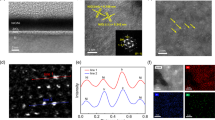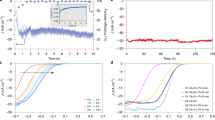Abstract
The rapidly increasing global demand for energy combined with the environmental impact of fossil fuels has spurred the search for alternative sources of clean energy. One promising approach is to convert solar energy into hydrogen fuel using photoelectrochemical cells. However, the semiconducting photoelectrodes used in these cells typically have low efficiencies and/or stabilities. Here we show that a silicon-based photocathode with a capping epitaxial oxide layer can provide efficient and stable hydrogen production from water. In particular, a thin epitaxial layer of strontium titanate (SrTiO3) was grown directly on Si(001) by molecular beam epitaxy. Photogenerated electrons can be transported easily through this layer because of the conduction-band alignment and lattice match between single-crystalline SrTiO3 and silicon. The approach was used to create a metal–insulator–semiconductor photocathode that, under a broad-spectrum illumination at 100 mW cm−2, exhibits a maximum photocurrent density of 35 mA cm−2 and an open circuit potential of 450 mV; there was no observable decrease in performance after 35 hours of operation in 0.5 M H2SO4. The performance of the photocathode was also found to be highly dependent on the size and spacing of the structured metal catalyst. Therefore, mesh-like Ti/Pt nanostructured catalysts were created using a nanosphere lithography lift-off process and an applied-bias photon-to-current efficiency of 4.9% was achieved.
This is a preview of subscription content, access via your institution
Access options
Subscribe to this journal
Receive 12 print issues and online access
$259.00 per year
only $21.58 per issue
Buy this article
- Purchase on Springer Link
- Instant access to full article PDF
Prices may be subject to local taxes which are calculated during checkout




Similar content being viewed by others
References
Fujishima, A. & Honda, K. Electrochemical photolysis of water at a semiconductor electrode. Nature 238, 37–38 (1972).
Lewis, N. S. et al. Solar water splitting cells. Chem. Rev. 110, 6446–6473 (2010).
Esposito, D. V., Levin, I., Moffat, T. P. & Talin, A. A. H2 evolution at Si-based metal–insulator–semiconductor photoelectrodes enhanced by inversion channel charge collection and H spillover. Nature Mater. 12, 562–568 (2013).
Kye, J. et al. Platinum monolayer electrocatalyst on gold nanostructures on silicon for photoelectrochemical hydrogen evolution. ACS Nano 7, 6017–6023 (2013).
Sun, K. et al. Nickel oxide functionalized silicon for efficient photo-oxidation of water. Energy Environ. Sci. 5, 7872–7877 (2012).
Chen, Y. W. et al. Atomic layer-deposited tunnel oxide stabilizes silicon photoanodes for water oxidation. Nature Mater. 10, 539–544 (2011).
Seger, B. et al. Hydrogen production using a molybdenum sulfide catalyst on a titanium-protected n plus p-silicon photocathode. Angew. Chem. Int. Ed. 51, 9128–9131 (2012).
Seger, B. et al. Using TiO2 as a conductive protective layer for photocathodic H2 evolution. J. Am. Chem. Soc. 135, 1057–1064 (2013).
Kenney, M. J. et al. High-performance silicon photoanodes passivated with ultrathin nickel films for water oxidation. Science 342, 836–840 (2013).
Reece, S. Y. et al. Wireless solar water splitting using silicon-based semiconductors and earth-abundant catalysts. Science 334, 645–648 (2011).
Pijpers, J. J. H. et al. Light-induced water oxidation at silicon electrodes functionalized with a cobalt oxygen-evolving catalyst. Proc. Natl Acad. Sci. USA 108, 10056–10061 (2011).
Sun, K. et al. Metal oxide composite enabled nanotextured Si photoanode for efficient solar driven water oxidation. Nano Lett. 13, 2064–2072 (2013).
Dasgupta, N. P. et al. Atomic layer deposition of platinum catalysts on nanowire surfaces for photoelectrochemical water reduction. J. Am. Chem. Soc. 135, 12932–12935 (2013).
Paracchino, A. et al. Highly active oxide photocathode for photoelectrochemical water reduction. Nature Mater. 10, 456–461 (2011).
Khan, S. U. M., Al-Shahry, M. & Ingler, W. B. Efficient photochemical water splitting by a chemically modified n-TiO2 . Science 297, 2243–2245 (2002).
Chen, X. B., Liu, L., Yu, P. Y. & Mao, S. S. Increasing solar absorption for photocatalysis with black hydrogenated titanium dioxide nanocrystals. Science 331, 746–750 (2011).
Warren, S. C. et al. Identifying champion nanostructures for solar water-splitting. Nature Mater. 12, 842–849 (2013).
Shi, J. et al. Interface engineering by piezoelectric potential in ZnO–based photoelectrochemical anode. Nano Lett. 11, 5587–5593 (2011).
McKone, J. R., Pieterick, A. P., Gray, H. B. & Lewis, N. S. Hydrogen evolution from Pt/Ru-coated p-type WSe2 photocathodes. J. Am. Chem. Soc. 135, 223–231 (2012).
Liao, L. et al. Efficient solar water-splitting using a nanocrystalline CoO photocatalyst. Nature Nanotech. 9, 69–73 (2013).
Khaselev, O. & Turner, J. A. A monolithic photovoltaic–photoelectrochemical device for hydrogen production via water splitting. Science 280, 425–427 (1998).
Li, Y. et al. Cobalt phosphate-modified barium-doped tantalum nitride nanorod photoanode with 1.5% solar energy conversion efficiency. Nature Commun. 4, 2566 (2013).
Higashi, M., Domen, K. & Abe, R. Highly stable water splitting on oxynitride TaON photoanode system under visible light irradiation. J. Am. Chem. Soc. 134, 6968–6971 (2012).
Li, Y. et al. Vertically aligned Ta3N5 nanorod arrays for solar-driven photoelectrochemical water splitting. Adv. Mater. 25, 125–131 (2013).
Powell, D. M. et al. Crystalline silicon photovoltaics: a cost analysis framework for determining technology pathways to reach baseload electricity costs. Energy Environ. Sci. 5, 5874–5883 (2012).
Swanson, R. M. A vision for crystalline silicon photovoltaics. Prog. Photovoltaics Res. Appl. 14, 443–453 (2006).
Sim, U. et al. N-doped monolayer graphene catalyst on silicon photocathode for hydrogen production. Energy Environ. Sci. 6, 3658–3664 (2013).
Wang, X. et al. High-performance silicon nanowire array photoelectrochemical solar cells through surface passivation and modification. Angew. Chem. Int. Ed. 50, 9861–9865 (2011).
Munoz, E. C., Schrebler, R. S., Orellana, M. A. & Cordova, R. Rhenium electrodeposition process onto p-Si(100) and electrochemical behaviour of the hydrogen evolution reaction onto p-Si/Re/0.1 M H2SO4 interface. J. Electroanal. Chem. 611, 35–42 (2007).
Strandwitz, N. C. et al. Photoelectrochemical behavior of n-type Si(100) electrodes coated with thin films of manganese oxide grown by atomic layer deposition. J. Phys. Chem. C 117, 4931–4936 (2013).
Lana-Villarreal, T., Straboni, A., Pichon, L. & Alonso-Vante, N. Photoelectrochemical characterization of p-type silicon electrodes covered with tunnelling nitride dielectric films. Thin Solid Films 515, 7376–7381 (2007).
McKee, R. A., Walker, F. J. & Chisholm, M. F. Crystalline oxides on silicon: the first five monolayers. Phys. Rev. Lett. 81, 3014–3017 (1998).
Yu, Z. et al. Advances in heteroepitaxy of oxides on silicon. Thin Solid Films 462–463, 51–56 (2004).
Warusawithana, M. P. et al. A ferroelectric oxide made directly on silicon. Science 324, 367–370 (2009).
Demkov, A. A. et al. Monolithic integration of oxides on semiconductors. ECS Transactions 54, 255–269 (2013).
McKee, R. A., Walker, F. J. & Chisholm, M. F. Physical structure and inversion charge at a semiconductor interface with a crystalline oxide. Science 293, 468–471 (2001).
Chambers, S. A. et al. Band discontinuities at epitaxial SrTiO3/Si(001) heterojunctions. Appl. Phys. Lett. 77, 1662–1664 (2000).
Chambers, S. et al. Band offset and structure of SrTiO3/Si(001) heterojunctions. J. Vac. Sci. Technol. A 19, 934–939 (2001).
Zhang, X. et al. Atomic and electronic structure of the Si/SrTiO3 interface. Phys. Rev. B 68, 125323 (2003).
Amy, F. et al. Band offsets at heterojunctions between SrTiO3 and BaTiO3 and Si(100). J. Appl. Phys. 96, 1635–1639 (2004).
Robertson, J. Band offsets of wide-band-gap oxides and implications for future electronic devices. J. Vac. Sci. Technol. B 18, 1785–1791 (2000).
Yu, Z. et al. Epitaxial perovskite thin films grown on silicon by molecular beam epitaxy. J. Vac. Sci. Technol. B 18, 1653–1657 (2000).
Chang, T. C., Jian, F. Y., Chen, S. C. & Tsai, Y. T. Developments in nanocrystal memory. Mater. Today 14, 608–615 (2011).
Haynes, C. L. & Van Duyne, R. P. Nanosphere lithography: a versatile nanofabrication tool for studies of size-dependent nanoparticle optics. J. Phys. Chem. B 105, 5599–5611 (2001).
Hsu, C. M., Connor, S. T., Tang, M. X. & Cui, Y. Wafer-scale silicon nanopillars and nanocones by Langmuir–Blodgett assembly and etching. Appl. Phys. Lett. 93, 133109 (2008).
Sze, S. M. & Ng, K. K. Physics of Semiconductor Devices (Wiley, 2006).
Wei, Y. et al. Mechanism of cleaning Si(100) surface using Sr or SrO for the growth of crystalline SrTiO3 films. J. Vac. Sci. Technol. B 20, 1402–1405 (2002).
Wagner, C. D. Sensitivity factors for XPS analysis of surface atoms. J. Electron Spectrosc. 32, 99–102 (1983).
Wagner, C. D., Davis, L. E. & Riggs, W. M. The energy dependence of the electron mean free path. Surf. Interface Anal. 2, 53–55 (1980).
Acknowledgements
The authors acknowledge research support from the National Science Foundation (ECCS-1120823 and Award DMR-1207342), the Office of Naval Research (Grant N00014-10-10489) and the Judson S. Swearingen Regents Chair in Engineering at the University of Texas at Austin.
Author information
Authors and Affiliations
Contributions
L.J., M.D.M., J.G.E. and E.T.Y. contributed to the design concept. L.J., X.L., S.W. and H.H. performed the fabrication process and measurements. M.D.M., A.B.P., A.A.D. and J.G.E. performed the MBE growth. All authors discussed the results and commented on the manuscript.
Corresponding author
Ethics declarations
Competing interests
The authors declare no competing financial interests.
Supplementary information
Supplementary information
Supplementary Information (PDF 642 kb)
Supplementary Movie 1
Supplementary Movie 1 (AVI 1459 kb)
Supplementary Movie 2
Supplementary Movie 2 (AVI 1008 kb)
Rights and permissions
About this article
Cite this article
Ji, L., McDaniel, M., Wang, S. et al. A silicon-based photocathode for water reduction with an epitaxial SrTiO3 protection layer and a nanostructured catalyst. Nature Nanotech 10, 84–90 (2015). https://doi.org/10.1038/nnano.2014.277
Received:
Accepted:
Published:
Issue Date:
DOI: https://doi.org/10.1038/nnano.2014.277
This article is cited by
-
Enhanced Photoelectrochemical Hydrogen Evolution on CuBi2O4 Photocathode with Silver as Conductive Channels
Catalysis Letters (2024)
-
Epitaxially grown silicon-based single-atom catalyst for visible-light-driven syngas production
Nature Communications (2023)
-
Atomically dispersed iridium catalysts on silicon photoanode for efficient photoelectrochemical water splitting
Nature Communications (2023)
-
Construction of novel P-Si/TiO2/HfO2/MoS2/Pt heterophotocathode for enhanced photoelectrochemical water splitting
Nano Research (2023)
-
Recent Advancements in Photoelectrochemical Water Splitting for Hydrogen Production
Electrochemical Energy Reviews (2023)



